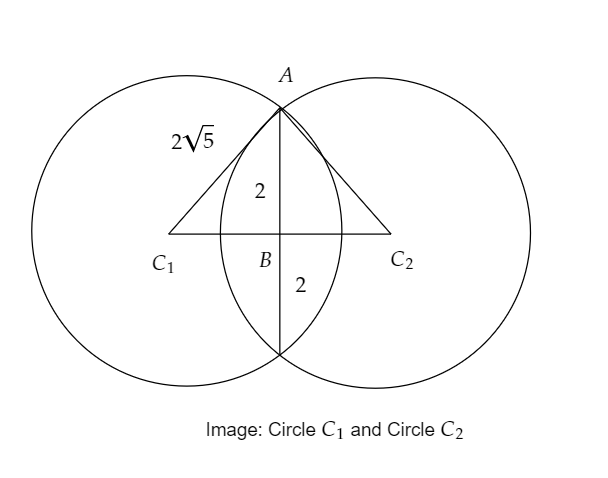
Let the latus rectum of the parabola \[{y^2} = 4x\] be the common chord to the circle \[{C_{1{\rm{ }}}}\] and \[{{\rm{C}}_2}\] each of them having radius \[2\sqrt 5 \]. Then the distance between the centers of the circle \[{C_{1{\rm{ }}}}\] and \[{{\rm{C}}_2}\]is,
A.8
B.\[8\sqrt 5 \]
C.\[4\sqrt 5 \]
D.12
Answer
219.9k+ views
Hint: First draw the diagram of the stated problem, from the diagram we can say that \[{C_1}B = B{C_2}\] as B is the middle point of the line \[{C_1}{C_2}\], therefore we can conclude that \[{C_1}{C_2} = 2{C_1}B = 2B{C_2}\] . Now, apply the Pythagoras theorem to obtain the value of \[{C_1}B\]. Multiply the obtained value of \[{C_1}B\] by 2, to obtain the required value.
Formula used:
Pythagoras theorem states that, for a right-angle triangle \[{\left( {hypotenuse} \right)^2} = {\left( {base} \right)^2} + {\left( {height} \right)^2}\] .
Complete step by step solution:
For the given parabola the latus rectum is 4 as in the general form \[{y^2} = 4ax\] the latus rectum is 4a.
So, the diagram of the stated problem is,

The given two circles have an equal radius, and it is given that the common chord of these two circles is the latus rectum of the parabola \[{y^2} = 4x\], here the length of latus rectum is 4 so, length of AB must be half of the length of the latus rectum. As the latus rectum divides the line \[{C_1}{C_2}\] into two equal parts so we can conclude that \[{C_1}{C_2} = 2{C_1}B = 2B{C_2}\] .
Now, it is a right-angle triangle.
Apply Pythagoras theorem on this triangle to obtain the value of the base.
\[{\left( {A{C_1}} \right)^2} = {\left( {{C_1}B} \right)^2} + {\left( {BA} \right)^2}\]
\[ \Rightarrow {\left( {2\sqrt 5 } \right)^2} = {\left( {{C_1}B} \right)^2} + {\left( 2 \right)^2}\]
\[ \Rightarrow 4 \times 5 = {\left( {{C_1}B} \right)^2} + 4\]
\[\begin{array}{l} \Rightarrow {\left( {{C_1}B} \right)^2} = 20 - 4\\{\rm{ = 16}}\end{array}\]
Therefore, \[{C_1}B = \pm 4\]
As the distance can-not be negative therefore \[{C_1}B = 4\]
Hence,
\[\begin{array}{c}{C_1}{C_2} = 2{C_1}B\\ = 2 \times 4\\ = 8\end{array}\]
Hence the Required value is 8.
Note: Students are often confused to calculate the latus rectum of a parabola. They do not take 4a as the latus rectum. They calculate the latus rectum as 1. But the correct latus rectum is 4.
Formula used:
Pythagoras theorem states that, for a right-angle triangle \[{\left( {hypotenuse} \right)^2} = {\left( {base} \right)^2} + {\left( {height} \right)^2}\] .
Complete step by step solution:
For the given parabola the latus rectum is 4 as in the general form \[{y^2} = 4ax\] the latus rectum is 4a.
So, the diagram of the stated problem is,

The given two circles have an equal radius, and it is given that the common chord of these two circles is the latus rectum of the parabola \[{y^2} = 4x\], here the length of latus rectum is 4 so, length of AB must be half of the length of the latus rectum. As the latus rectum divides the line \[{C_1}{C_2}\] into two equal parts so we can conclude that \[{C_1}{C_2} = 2{C_1}B = 2B{C_2}\] .
Now, it is a right-angle triangle.
Apply Pythagoras theorem on this triangle to obtain the value of the base.
\[{\left( {A{C_1}} \right)^2} = {\left( {{C_1}B} \right)^2} + {\left( {BA} \right)^2}\]
\[ \Rightarrow {\left( {2\sqrt 5 } \right)^2} = {\left( {{C_1}B} \right)^2} + {\left( 2 \right)^2}\]
\[ \Rightarrow 4 \times 5 = {\left( {{C_1}B} \right)^2} + 4\]
\[\begin{array}{l} \Rightarrow {\left( {{C_1}B} \right)^2} = 20 - 4\\{\rm{ = 16}}\end{array}\]
Therefore, \[{C_1}B = \pm 4\]
As the distance can-not be negative therefore \[{C_1}B = 4\]
Hence,
\[\begin{array}{c}{C_1}{C_2} = 2{C_1}B\\ = 2 \times 4\\ = 8\end{array}\]
Hence the Required value is 8.
Note: Students are often confused to calculate the latus rectum of a parabola. They do not take 4a as the latus rectum. They calculate the latus rectum as 1. But the correct latus rectum is 4.
Recently Updated Pages
Geometry of Complex Numbers Explained

Electricity and Magnetism Explained: Key Concepts & Applications

JEE Energetics Important Concepts and Tips for Exam Preparation

JEE Isolation, Preparation and Properties of Non-metals Important Concepts and Tips for Exam Preparation

JEE Main 2021 July 25 Shift 1 Question Paper with Answer Key

JEE Main 2021 July 22 Shift 2 Question Paper with Answer Key

Trending doubts
JEE Main 2026: Application Form Open, Exam Dates, Syllabus, Eligibility & Question Papers

Derivation of Equation of Trajectory Explained for Students

Hybridisation in Chemistry – Concept, Types & Applications

Understanding the Angle of Deviation in a Prism

Understanding Atomic Structure for Beginners

How to Convert a Galvanometer into an Ammeter or Voltmeter

Other Pages
JEE Advanced Marks vs Ranks 2025: Understanding Category-wise Qualifying Marks and Previous Year Cut-offs

Understanding Centrifugal Force in Physics

JEE Main Marking Scheme 2026- Paper-Wise Marks Distribution and Negative Marking Details

Degree of Dissociation: Meaning, Formula, Calculation & Uses

Ideal and Non-Ideal Solutions Explained for Class 12 Chemistry

Understanding Average and RMS Value in Electrical Circuits




